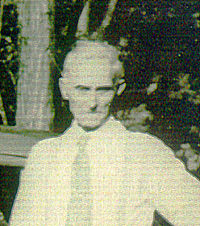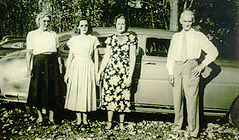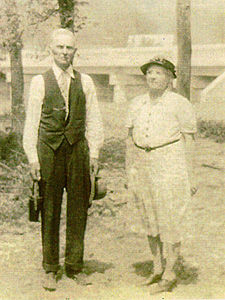 Born in 1871, James William Baynum was the only child of a Confederate soldier from Flag Spring, Ky., who (after the Civil War) at age 60 married a 35-year-old lady. While reading a popular magazine of the day, The Youth’s Companion, James was intrigued by an ad for the Phonographic Institute of Cincinnati, managed by Jerome Howard and Ben Pitman. He enrolled in their correspondence course in shorthand, and after some months of progress submitted his name in the magazine under the section “Correspondents Wanted”. He received shorthand letters from a number of secretaries, one of whom was Laura Bush of Indian Hill, Madisonville, Ohio. As they exchanged letters in shorthand, correcting each other’s mistakes and practicing techniques, they exchanged ideas and opinions. It became apparent that they shared a great deal in common, and after four years of correspondence James traveled over the Ohio River to meet Laura.
Born in 1871, James William Baynum was the only child of a Confederate soldier from Flag Spring, Ky., who (after the Civil War) at age 60 married a 35-year-old lady. While reading a popular magazine of the day, The Youth’s Companion, James was intrigued by an ad for the Phonographic Institute of Cincinnati, managed by Jerome Howard and Ben Pitman. He enrolled in their correspondence course in shorthand, and after some months of progress submitted his name in the magazine under the section “Correspondents Wanted”. He received shorthand letters from a number of secretaries, one of whom was Laura Bush of Indian Hill, Madisonville, Ohio. As they exchanged letters in shorthand, correcting each other’s mistakes and practicing techniques, they exchanged ideas and opinions. It became apparent that they shared a great deal in common, and after four years of correspondence James traveled over the Ohio River to meet Laura.
Laura Belle Bush was a direct descendant of Abraham Bush, a War of 1812 veteran and one of the pioneer families of Indian Hill. Both her father and grandfather were farmers, known to have grown fruit. An avid learner, she studied the shorthand flourishes, and in practicing the shortened versions for phrases, she became acquainted with James Baynum, whom she married in 1897. The newlyweds returned to Kentucky to tend to James’ father, an elderly widow. While there, their only child, Viola, was born in 1898. When James’ father died, the couple moved back to Indian Hill to help care for Laura’s elderly father. James was respected by many on the hill, and he acquired the nickname “the Kentucky Wonder” from his new friends in Ohio. (Kentucky Wonder was a popular bean grown by many 19th century farmers.) As Indian Hill was a rural farm community in the late 19th century, this name fit the tall lanky fellow who moved north from Kentucky.
 The family resided on Indian Hill Rd. in a classic two-story wood frame house. In 1907, the house was remodeled. Windows were replaced, Victorian trim was removed, a larger front porch, new roof, and third floor were added, and a hot water heating system and interior bathroom were installed. Baynum, like many of his neighbors, frequently went to Madisonville or Plainville for commerce. He had a charge account at Schneider’s (the grocery store), a bank account at Madison Savings and Loan, and bought dry goods at Mettman’s. The Baynums attended the Methodist Church in Madisonville, but in later years James became active at Armstrong Chapel, where he was known to have transported the minister to and from services. A charter member of the Indian Hill Horse Rangers in 1903, he was one of the 19 incorporators of the first Rangers organization which received its charter in 1910. Also, at the Jefferson School, where his daughter and granddaughter were students, he served on the Board of Education. Photography and geology were two of his hobbies. Cultivating the Ohio land that belonged to his wife, farming was James’ primary source of income. He also raised tobacco on a farm located on the Licking River in Kentucky.
The family resided on Indian Hill Rd. in a classic two-story wood frame house. In 1907, the house was remodeled. Windows were replaced, Victorian trim was removed, a larger front porch, new roof, and third floor were added, and a hot water heating system and interior bathroom were installed. Baynum, like many of his neighbors, frequently went to Madisonville or Plainville for commerce. He had a charge account at Schneider’s (the grocery store), a bank account at Madison Savings and Loan, and bought dry goods at Mettman’s. The Baynums attended the Methodist Church in Madisonville, but in later years James became active at Armstrong Chapel, where he was known to have transported the minister to and from services. A charter member of the Indian Hill Horse Rangers in 1903, he was one of the 19 incorporators of the first Rangers organization which received its charter in 1910. Also, at the Jefferson School, where his daughter and granddaughter were students, he served on the Board of Education. Photography and geology were two of his hobbies. Cultivating the Ohio land that belonged to his wife, farming was James’ primary source of income. He also raised tobacco on a farm located on the Licking River in Kentucky.
 James Baynum’s wife died when he was 75; and when his only child, Viola, died in 1959, he moved to Dayton to live with his granddaughter, but still traveled to the farm every weekend. After several years, he returned to the hill with his granddaughter and great grandson. When he died at his residence on March 3, 1965, he was 94, the oldest resident of Indian Hill.
James Baynum’s wife died when he was 75; and when his only child, Viola, died in 1959, he moved to Dayton to live with his granddaughter, but still traveled to the farm every weekend. After several years, he returned to the hill with his granddaughter and great grandson. When he died at his residence on March 3, 1965, he was 94, the oldest resident of Indian Hill.
Soon afterward, the original farmhouse was razed. His family saved his brief autobiography, Bits of Baynum History, in which he wrote, “Land in Indian Hill soon became real valuable. We sold six acres… for $27,000.” A Baynum descendant still lives in the Village and treasures the memory of “the Kentucky Wonder.”
